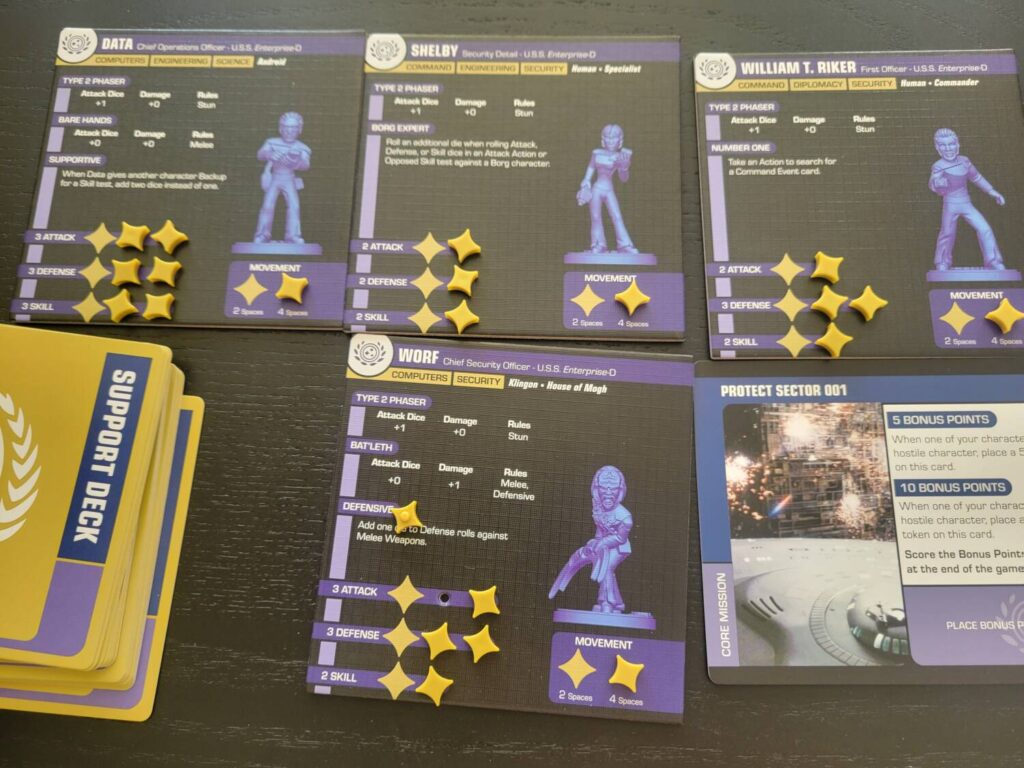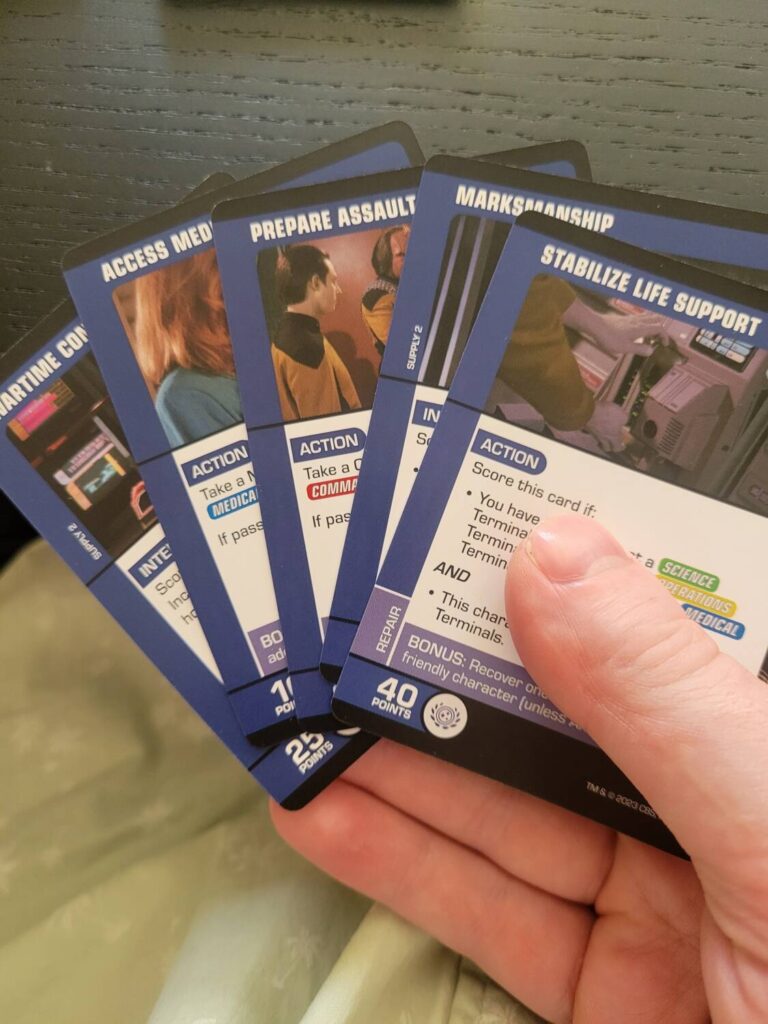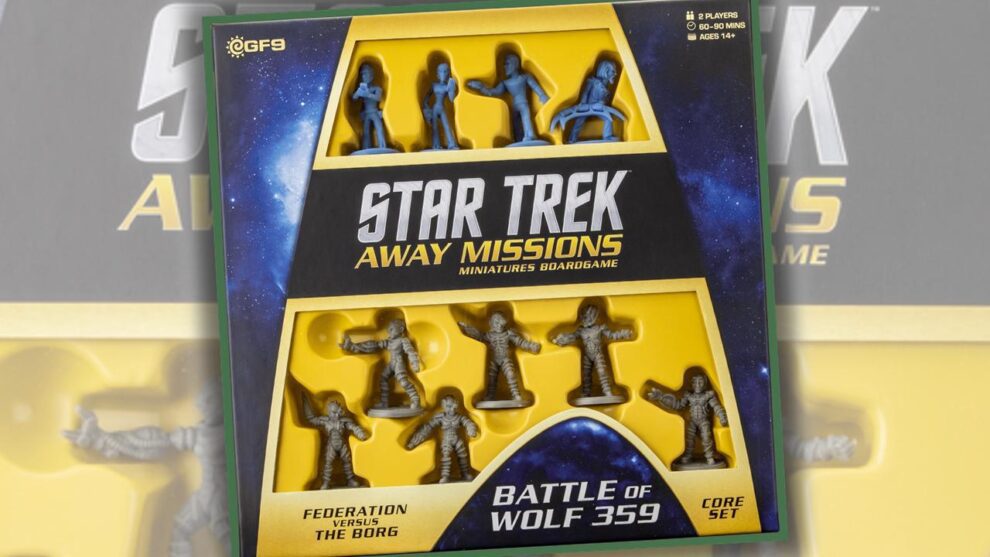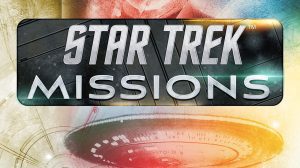Disclosure: Meeple Mountain received a free copy of this product in exchange for an honest, unbiased review. This review is not intended to be an endorsement.
Don’t tell my erudite friends but skirmish games, in particular, Star Wars: Imperial Assault, got me back into board gaming (even though I find the entirety of the modern Star Wars franchise unbearably boring). I love pushing miniatures around on a grid of some kind and making them shoot each other.

Now, I do love Star Trek, the show about people solving problems with talking, and I’m happy to say that if you’re looking for a highly approachable two-player skirmish game, Star Trek: Away Missions fits the bill. While the way you win can feel slightly disjointed as a game, it often ends up feeling more in the spirit of a Star Trek set piece, where a character has to perform some jargon-filled objective while dodging phaser fire.
Yellow Alert
Away Missions has you selecting your team from amongst Romulans, Klingons, Borg, and Federation factions. For this review, I had access to the starter kits for each. As I understand it, you can get other collections of minis which add characters you can swap in, more cards to build your decks with, and additional options for objectives.
You have a deck of Support Cards, and a deck of Mission Cards. The former contain various pieces of equipment that you can use to enhance your squad and events that you can use to be annoying to the other player. The latter are contracts, which you fulfill upon accomplishing their stated goals. Sometimes, these objectives require you to play them and then perform a special action (or series of actions) listed on the card. Before you beam into battle, you can customize each of these decks to your liking, or you can just use starter decks, which is what I typically like to do with a game like this.
Each round, you’ll alternate activating one of your characters (or reactivating a character with a bonus token if you started the round with fewer characters than your opponent) and you’ll have two actions to take. You can move, which is less effective when your character is damaged, attack, or take special actions, which are varied depending on the characters you’re playing. There’s quite a few options, and one of the virtues of the game is its more “euro-y” approach to the setting, where many times, you’re going to be positioning yourself and interacting with the board rather than blasting other players. Though if you’re playing Klingons or Borg, there’s plenty of blasting to be had. Sometimes you need to solve a problem with a phaser blast to the face.

At the end of three rounds of play, the player who scored the most points from their played mission cards and their BIG MISSION card played at the beginning of the match wins.
Got Star Trek problems? Away Missions has Star Trek solutions
I think Away Missions is a winner for folks who enjoy skirmish games. I’ve heard comparisons to Warhammer: Underworlds, but I haven’t played that, so I’m not sure. But, I can say the way this game handles line of sight and die rolls is very pleasing.
Line of sight is one of the most annoying mechanics in gaming as far as I’m concerned. There’s nothing more irritating than having to take a break from the excitement to pull a ruler out and draw lines from one character’s base or position or something to determine if they can shoot at someone else. BORING. Away Missions has a novel solution for this problem. The board is laid out in irregular sized spaces, and you measure from the space, rather than the character. So, if you can eyeball a line between several spaces and they have open doorways (a character in a space means there’s an open doorway) you can shoot. Most tactical considerations can be resolved in a split second thanks to this, which keeps the pace quick and lively. Big kudos to the designers for this.

Second, the dice rolls. Basically, you compare stats, and each player rolls a maximum of six dice according to their stat lines. There’s a little guide for you to line your dice up in, highest to lowest. When two dice are being compared, the higher one wins, but if there’s no dice to compare with, a four or better is a success. Sure, there’s plenty of modifiers and fun changes to think about, but overall, it’s breezy and tension filled.
A dangerous, savage child-review
For the Star Trek nerds like myself, there’s plenty of chrome to be had. You’ve got the tree-hugging federation with its dorky-science kid objectives where you need to tricorder the phase manipulator so the warp core can triglyceride or whatever; the Klingons who are obsessed with honor-as-a-resource; Romulans are sneaky; and the Borg just wanna assimilate. Each set comes with a girthy amount of deck customization possibilities, and each expansion set gives added value for players looking to really get into the system.
I can’t speak to the multiplayer experience, but this is one of the more enjoyable two-player skirmish games I’ve tried, and GF9 continues to put out quality content. I can’t wait for their upcoming re-release of Star Trek: Ascendancy, which is one of my all time favorite 4X games. BEAM ME UP BABYYYY!











Add Comment